“You called the right place! How can we make you smile?” See how easy it was to catch your attention with a simple greeting? You would be surprised how often a simple acknowledgment of the customer will improve an online review. When working in the home service industry, customer service is your brand. It’s what Read more
Industry Blogs

“You called the right place! How can we make you smile?”
See how easy it was to catch your attention with a simple greeting? You would be surprised how often a simple acknowledgment of the customer will improve an online review. When working in the home service industry, customer service is your brand. It’s what people remember about you long after a job is completed. It’s the thing that can help drive your business to the next level.
As service providers, it is important to realize that, in today’s world, communicating with your customer directly, has become a necessity. With people finally getting a chance to converse face-to-face after a long period of strict social distancing guidelines, the customer wants to get to know you. No longer can we as service providers hide behind the bag in 2021. Which means it’s the perfect season for sharpening our soft skills such as controlling voice patterns and body language now that we are spending more time face to face. These skills are vital when communicating with customers.
Communicating with a customer is about building professional trust. When a customer feels that you have listened to them and understood what they need, they trust that you can accomplish the job and that expectations are clear. That is when the skills we’ve mastered as service providers come into play, and we follow through with what we promised our customers. This allows your team to ask the customer for additional and referral business, as well as that five-star review that will help create credibility online.
The Wow Factor
The No. 1 rule of any service provider is to go above and beyond expectations. We call this the “wow factor.” The wow factor is doing something extra without expectation; meaning don’t tell the customer you’re going to do it as part of the job. Instead, tell them you did it to say, “thank you.” These don’t have to be major jobs either. It can be as simple as changing air filters when repairing an HVAC unit. The key to this is to start the job the customer paid you to do, add something extra to the deal and then let the customer know at the end. Effectively communicating this is also paramount. Don’t make it look like the extra job was a hassle. Use proper body language and tone to show the customer you were excited and happy to do the job. The technician needs to list this “wow factor” on their invoice at full price then discount it off showing the customer that you are saying “thank you” by going ahead and covering that expense today.
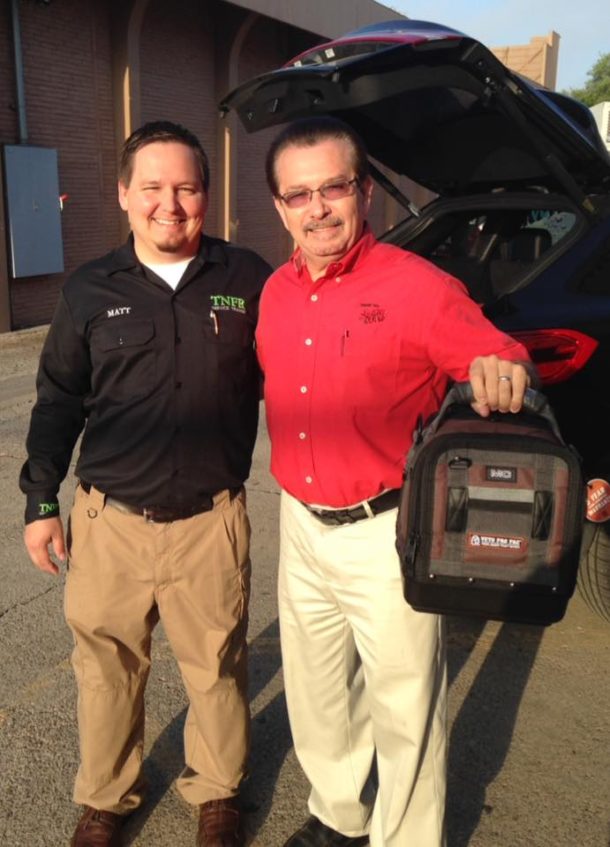
The Good, The Bad, The Lost Customer
It’s funny. Research shows us that the No. 1 reason a customer leaves any company and finds a replacement is a lack of customer service. When there is poor communication, the customer doesn’t feel that he or she has been truly heard. Customer service is about communicating with the customer in a simple form and ensuring they know you’re listening. Using soft skills to keep the customer engaged is key. Not only will it reaffirm they are your No. 1 priority, but it will also help avoid potential conflicts with the customer. If they feel listened to and acknowledged, they will become customers for life and begin to send referrals your way.
The Golden 3
So, after all this discussion, you are probably wondering what are the most important soft skills a service provider should understand and master to improve customer service and satisfaction. In my experience, there are three:
- Listening to the customer: Listen to the customer’s whole question before thinking about how you are going to respond. If a customer finishes their entire question and you already know the answer, then there is a good chance you didn’t actually listen. One thing that we have learned is most field staff stop listening to the customer in the first 10 words that are said. Most customers don’t say what they mean until the last 10 words. So, oftentimes technicians think they are working in the right direction, and they’re working on the completely wrong thing. Following this rule helps ensure all parties’ expectations are clear.
- Skillset training, both technical and communications: We are creatures of regression. We automatically lose things that we don’t practice or sharpen. Making sure you are setting time aside as a company for all your field staff to sharpen their technical and soft skills multiple times a week (even if it’s only 15-30 minutes) helps to limit their loss of knowledge.
- The ability to shut up: This is probably the most important skill a field tech can learn. When you ask a customer a question, STOP and wait for their response. When a technician asks a question, they tend to get uncomfortable with the silence. So, the tech ends up asking another question to break the silence, which in turn completely breaks the customer’s train of thought. It’s important to know that when you ask a question and then SHUT UP it may be uncomfortable for you, but it’s not for the customer. It doesn’t register as silence to the customer because they are still processing the information you just presented. So, learn to shut up and let them finish their process…respectfully.
If you can follow these three simple rules and processes, I’m confident you will improve your customer service skills and help retain customers while gaining some new ones, too.
 Matt Koop is Vice President of Training and Implementation for The New Flat Rate, a home service menu-selling system designed to put profit directly into the hands of plumbing, electrical, and HVAC contractors. For more information visit www.thenewflatrate.com or email info@menupricing.com.
Matt Koop is Vice President of Training and Implementation for The New Flat Rate, a home service menu-selling system designed to put profit directly into the hands of plumbing, electrical, and HVAC contractors. For more information visit www.thenewflatrate.com or email info@menupricing.com.

How contractors can build trust, set their teams up for success and keep customers satisfied The hard costs of inconsistent service — lost hours of billable work due to no follow-up, or unbilled time spent correcting mistakes and oversights — add up quickly for service contractors. But the true long-term damage of inconsistent service is Read more
How contractors can build trust, set their teams up for success and keep customers satisfied
The hard costs of inconsistent service — lost hours of billable work due to no follow-up, or unbilled time spent correcting mistakes and oversights — add up quickly for service contractors. But the true long-term damage of inconsistent service is harder to measure. It’s not always obvious how to prevent or repair it, however hidden costs of inconsistent service frequently reveal themselves in predictable ways. Contractors who know the common warning signs can minimize loss, build better teams and keep their company on the winning track.

Hidden costs
When customers don’t feel like they are a priority, the loss of trust is contagious. Some of the results are tangible, like a decrease in online reviews and referrals. Others are harder to see.
I often tell business owners I’m the most dangerous kind of customer to lose, because you’ll never know I’m gone. I don’t fight battles. I’ll just move on and find someone else. An angry customer who complains is giving you a chance to fix the problem. But how do you fix a problem you don’t even know about?
And it’s not just paying customers who are affected by poor service. In today’s employment market, where demand for qualified technicians and installers is at an all-time high, potential employees rely on the same search results and online reviews as customers. Considering the high stakes of the current labor shortage, it’s critical that contractors convey trust and reliability to service professionals looking for new opportunities.
Internal signs
Besides being alert for changes in reviews and referrals, business owners and leadership teams should always be on the lookout for signs that internal breakdown is leading to external service issues.
Personality conflicts are a visible indication of a culture needing improvement. When employees don’t get along, crucial pieces of information fall through the cracks. Conflicts between essential team members, like dispatch and technicians, can have a devastating effect on your team’s effectiveness. Make sure you have adequate training and other resources in place so employees feel comfortable discussing any issues with their managers and keep an eye on how team members get along.
Poor service also reflects a lack of training and tools. Clearly defined lines of communication help employees settle potential internal issues before they create problems. Telephone scripts set out concrete next steps for meeting customer expectations. (It’s also crucial that managers take advantage of recorded calls to monitor how those scripts are executed.) Setting standards and schedules for follow-ups ensures customers feel secure with your service and support.
Positive principles
In order to set the right steps for team members to keep service reliable, contractors must commit to the key principles of customer care.
- Follow up and follow through: The last thing we want to do is make it more difficult for the customer. If they have to pick up the phone and call us again, we’re not making it easier for them. Make it easy for them to work with us: Identify the next steps; make sure internal messages are passed on; follow up with a customer even if you don’t have the final answer. It’s OK to say, “Mrs. Jones, we still haven’t figured out the solution, but we’re working on it and didn’t want you think we’d forgotten about you.”
- Communicate effectively: Show empathy and generate rapport with customers when they call. If they call and someone is just giving out prices over the phone, they’re not going to trust you. We need to communicate the value of what we do, because they’re not calling just to ask for a price. They’re looking for a solution. They’re looking for the right fit, and if you invest time in building scripts that help them get there, they’ll trust you and build on that.
- Create a positive experience: There’s an actual scientific fact called the service recovery paradox. It says that you see an immediate surge in loyalty when a service failure is followed by a strong recovery that exceeds the customer’s expectations. It doesn’t matter what business you’re in or what you’re selling. There’s a huge increase in loyalty when you take care of someone after a service failure. They’re going to stay with you longer and give you more referrals because they know you’ll make it right.
 Catherine Bares is a service coach and trainer at Business Development Resources (BDR) with over 21 years of experience in the HVAC industry. She is passionate about service and using great customer experiences to increase revenue while building long-term relationships within the community.
Catherine Bares is a service coach and trainer at Business Development Resources (BDR) with over 21 years of experience in the HVAC industry. She is passionate about service and using great customer experiences to increase revenue while building long-term relationships within the community.
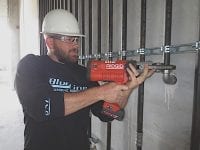
As a contractor, you’re always looking for ways to do a job faster without compromising quality. Completing jobs in the estimated time (or faster) allows a company to take on more work and earn more revenue while keeping clients happy. Conversely, taking longer than expected results in fewer jobs completed, less revenue, and unhappy clients Read more
As a contractor, you’re always looking for ways to do a job faster without compromising quality.
Completing jobs in the estimated time (or faster) allows a company to take on more work and earn more revenue while keeping clients happy. Conversely, taking longer than expected results in fewer jobs completed, less revenue, and unhappy clients.
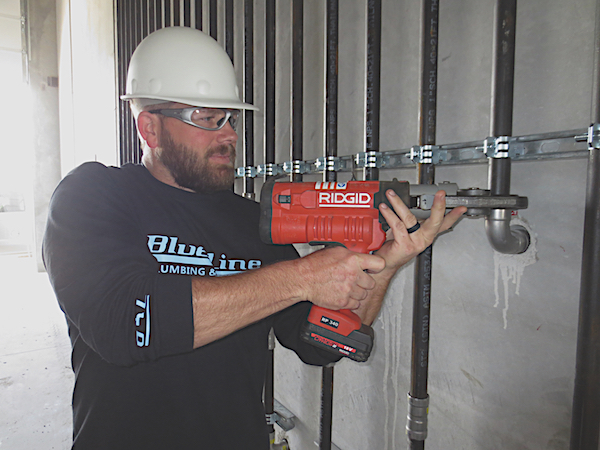
And the margin of profitability is slim.
Consider this estimate for a simple residential water heater replacement:
- Installation billable hours 1.5
- Hourly break-even rate $300
- Labor + 35% net profit margin (NPM) $692
- Materials $575
- Materials + 35% NPM $885
- Total Flat Rate Price (FRP) $1577
But what if the installation takes two hours instead of 1.5 hours? That’s only an additional 30 minutes, but it eliminates nearly two-thirds of the original net profit (or $150).
This need for speed is one of the reasons pressing is replacing soldering and welding as the preferred way to join pipe. Pressing delivers a 30% to 90% time savings for ½” to 4″ connections, depending on the material. Connections can be made in as quickly as seven seconds or less.
Pressing saves time in other ways as well. It connects when wet so there’s no need to drain the system. Since no flame is required, setup is minimal and free of worries about fumes and venting. The need for burn permits and fire watches is eliminated. Less equipment also means less time lugging it to and from the worksite.
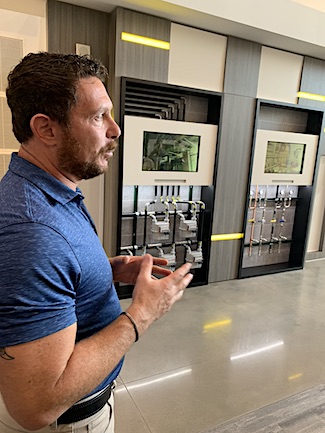
Not only does press technology save time (and money) on the job; the most significant savings may be upfront. The technology is simple. Position the tool and press a button – it’s really not much more complicated than that. Teaching a tech to solder or weld requires far more training and investment on the part of the company. With less training required for pressing, techs can get into the field sooner and start completing jobs. All of which saves the company money.
And without the need to hire or train certified welders it’s easier for a contractor to recruit and deploy workers, an important edge when hiring in the trades nowadays.
Viega introduced its press technology in Germany in 1989 and brought it to North America in 1999. In the two decades it’s been in use here, it’s been steadily winning converts. It can be used to connect everything from copper and steel to PEX and stainless steel and can be used in industrial, commercial and residential applications.
Pressing is not only faster than soldering and welding, it’s also more reliable. Viega’s press systems remove the variables found in traditional methods of pipe joining and stabilize the labor required to install. For even greater confidence, Viega’s Smart Connect® technology easily identifies un-pressed connections during pressure testing.
Still need some convincing that pressing can mean the difference between losing and earning money? Here’s another example of adding a gas line for a new cooktop:
Billable hours to route 20’ through crawlspace to range 3.0
- Hourly break-even rate $300
- Labor + 35% NPM $1384
- Materials $60
- Materials + 35% NPM $93
- Total FRP $1477
What if the installation takes two hours longer than estimated because the crawlspace is full of junk? That’s a labor loss on the job and $923 left on the table. Pressing pipe can’t unclutter a crawlspace, but it is a smart way to keep time on your side.
 Bo DeAngelo is Manager, Technical Training, at Viega LLC.
Bo DeAngelo is Manager, Technical Training, at Viega LLC.

Measuring tools are a vital tool in nearly every trade and every phase of construction. Measuring tools are often both the first step and the last step in completing jobs on the worksite. Whether a contractor is using a cross-line laser to align electrical outlets or an estimator using a laser distance measure to calculate Read more
Measuring tools are a vital tool in nearly every trade and every phase of construction. Measuring tools are often both the first step and the last step in completing jobs on the worksite. Whether a contractor is using a cross-line laser to align electrical outlets or an estimator using a laser distance measure to calculate area for flooring, nearly all trades are increasing usage of measuring tools. In turn, this increases the need for manufacturers to produce tools that offer enhanced precision, extra durability, and fit into more use cases than ever before. From plumb bobs to box lasers to chalk lines, measuring tools have seen perhaps the largest shift out of any other category of power tools.
Overall, measuring and leveling has become a faster, easier, and more affordable process than ever before. One way to think about the evolution of measuring tools is to compare it to the evolution of cell phones. When we look back at the very first cell phone, its purpose was to make calls. Now, cell phones offer much more than simply the ability to place a call. There’s consistently new iterations of cell phones, updates to applications, and new capabilities that enable users to do more with one device and do it more efficiently. Similarly, we are continually learning about new ways that measuring tools are being used on jobsites, offering us insight on how to make these tools as useful as possible.
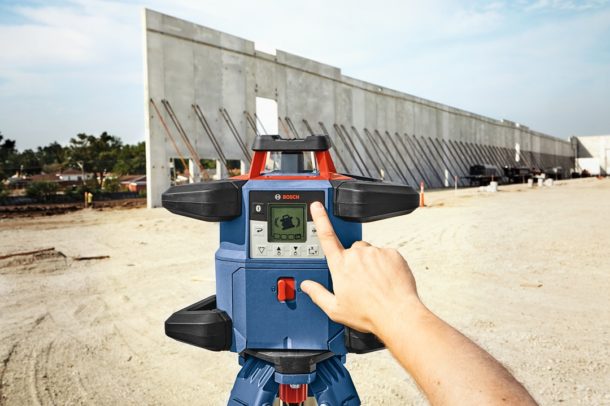
For starters, the laser technology used in measuring tools has improved tremendously with the shift from red beam lasers to green beam lasers in the past five years or so. Green is a color more visible to the human eye and thus scientifically, we can see the green beam laser better than red. In some environments where you might have ambient light shining onto the workspace, having additional visibility on the job site and longer ranges of laser light to work with is vital.
We have also seen a shift in producing measuring tools to be more compact, yet more durable, than ever before. As a direct result of listening to user feedback, manufacturers have begun to ensure that a measuring tool on the jobsite is built just as tough as the job itself, but also compact enough to ensure portability. We now see measuring tools that can fit in a tool belt or a case that is easily transported on a person, or alongside them as they move through their day. And it’s worth mentioning that these newer compact tools still carry great accuracy in their small package.
With the measuring tools market expanding to serve increasingly more trades and industries, we have also seen additional capabilities arise depending on the use. For example, a new high-end rotary laser might now offer UCAL, or user calibration. This is a way to connect the tool to a smart device and allow the user to calibrate their laser on site. This is especially useful in cases where a rotary laser, which is stood upright, can potentially get knocked out of place or slightly shifted. With UCAL, users can do their own accuracy check to ensure they are always working off of a level benchmark. Another similar tool capability on the rise is the option for connectivity, which has become an absolute necessity in the measuring tools category. Added connectivity to smart devices allows users to document their work digitally and immediately transfer detailed and accurate measurements off to a coworker or an office. The ability to document measurements in this way has created meaningful ecosystems and provided insight into how manufacturers can make measuring tools even more useful and accurate, and ultimately increase productivity on the jobsite.
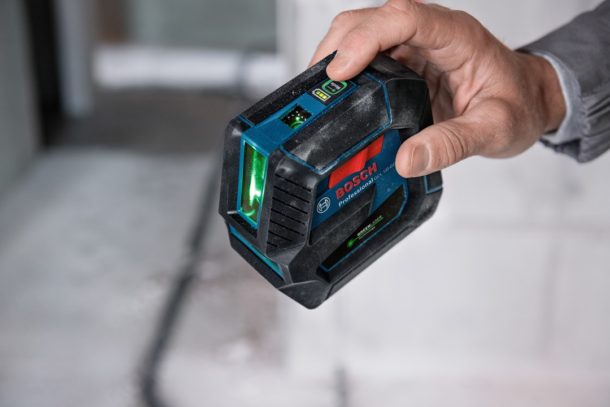
Overall, throughout the past 5-10 years measuring tools have become more accurate, useful, and durable than ever before. And new technological advances have allowed measuring tools to become fast, easier, and more efficient. With the growth of the measuring tool market and increase in overall demand, these tools have also become more cost-effective. A large range of use cases for measuring tools means there can be a tool for every job. We envision a world in which every user has a measuring tool that fits their individualized needs on the jobsite – and we are certainly up for the challenge to get them there.
 By Linda Tait, Business Unit Director, Measuring Tools at Bosch Power Tools
By Linda Tait, Business Unit Director, Measuring Tools at Bosch Power Tools

Dain Hansen is vice president of Government Relations, The IAPMO Group. He lends his frequent perspective of Capitol Hill, and the plumbing industry. Here is an edited version of his update from July 30, 2021: Congressional Update. Finally, an Infrastructure Bill. The House passed an infrastructure bill Thursday that would direct more than $700 billion Read more
 Dain Hansen is vice president of Government Relations, The IAPMO Group. He lends his frequent perspective of Capitol Hill, and the plumbing industry.
Dain Hansen is vice president of Government Relations, The IAPMO Group. He lends his frequent perspective of Capitol Hill, and the plumbing industry.
Here is an edited version of his update from July 30, 2021:
Congressional Update.
Finally, an Infrastructure Bill. The House passed an infrastructure bill Thursday that would direct more than $700 billion over five years for roads, railways, electric vehicles, and water, with Democrats set to use the policy to negotiate on a broader infrastructure package. The bill (H.R. 3684), passed in a largely party-line vote of 221-201, faced opposition from Republicans who criticized climate provisions and a lack of funding measures. The passage comes a week after a bipartisan group of senators and President Joe Biden agreed on a separate, nearly $1 trillion infrastructure framework that includes baseline spending.
But combining the proposals and coming to an agreement on how to pay for the legislation will be a heavy lift. Several authorizing committees in both chambers have jurisdiction over infrastructure, with different ideas for how to implement policy. Adding to the urgency is a Sept. 30 deadline to reauthorize surface transportation programs, regardless of whether a larger infrastructure deal is cut. DeFazio said the House bill and Senate bipartisan agreement are “within shouting distance” on spending levels, but that the Senate proposal is only a broad outline that lacks any detailed policy proposals.
The House measure includes historic levels of investment for drinking and wastewater infrastructure. The legislation would authorize $53 billion over the next decade for the Drinking Water State Revolving Fund, and $40 billion through fiscal 2026 for the Clean Water State Revolving Fund, which provides low-cost loan financing to communities for a range of water infrastructure projects. The Clean Water fund has not been reauthorized since 1988, though appropriators fund the critical program each year. The funds comprise the bulk of the water infrastructure investment in the bill. The bill also would include another $45 billion to fully replace lead service lines throughout the country. President Biden will have to use his clout to sell the bill to Democrats who don’t think it does enough on infrastructure and green energy.
After the Infrastructure Bill, the Budget Resolution. Many Democrats on Capitol Hill are more interested in a second package focused on climate change and social spending. The Senate will turn to a $3.5 trillion budget resolution once it passes the bipartisan infrastructure bill. Approving the budget resolution is a necessary first step in passing that large package of domestic spending and tax increases in the fall through the budget reconciliation process, which only requires a majority vote in the Senate (the process sidesteps the usual 60 vote procedural threshold for most legislation). Senate Democrats should be able to get all 50 of their members to support the resolution, though it is clear that some moderate Democrats like Senator Kyrsten Sinema (D-AZ) are unlikely to support the full $3.5 trillion of spending. Consequently, Democrats likely will need to lower the amount of spending in the bill. Even a smaller-scale bill will include a massive amount of spending that would be funded by significant increases in taxes on businesses and wealthier individuals. Votes in the Senate and House on this spending package (as on the bipartisan infrastructure package) will be close, and the possibility of a failed vote cannot be dismissed.
Unhappy Progressives. One dynamic that could tank these two bills is the increasing unhappiness of more progressive members of the Democratic caucus in both the House and Senate. They think the bipartisan infrastructure bill doesn’t do enough to support spending on green energy, and mass transit or to promote union work requirements. They also are unhappy with Senator Sinema’s opposition to a $3.5 trillion spending bill since many progressives saw that as a low water mark for spending. Even after the passage of a $1.9 trillion COVID relief bill earlier this year, progressives want to “go big” on domestic spending and thought that their new majorities in the House and Senate would pave the path forward to do so. It will be up to President Biden to calm this intra-party frustration and get the party behind these measures.
State and Local Update.
Legionnaires Cases Spike in Chicago. The Chicago Department of Public Health is investigating after 49 cases of Legionnaires’ disease were reported in Chicago since July 1, resulting in 15 hospitalizations and two deaths. This month’s case count represents a substantial increased compared to the last two years, with 16 total cases reported in 2020 and 13 in 2019, according to CDPH. No common source has been identified.
A Drought So Dire That a Utah Town Pulled the Plug on Growth. Oakley, about an hour’s drive east of Salt Lake City, imposed a construction moratorium on new homes that would connect to the town’s water system. It is one of the first towns in the United States to purposely stall growth for want of water in a new era of megadroughts. But it could be a harbinger of things to come in a hotter, drier West. Groundwater and streams vital both to farmers and cities are drying up. Fires devour houses being built deeper into wild regions and forests. Extreme heat makes working outdoors more dangerous and life without air-conditioning potentially deadly.
While summer monsoon rains have brought some recent relief to the Southwest, 99.9 percent of Utah is locked in severe drought conditions and reservoirs are less than half full. Yet cheap housing is even scarcer than water in much of Utah, whose population swelled by 18 percent from 2010 to 2020, making it the fastest-growing state. Oakley is planning to spend as much as $2 million drilling a water well 2,000 feet deep to reach what officials hope is an untapped aquifer. But 30 miles north of Oakley, near the Echo Reservoir—28% full and dropping—is the town of Henefer, where new building has been halted for three years. Right now, Henefer is trying to tap into new sources to provide water for landscaping and outdoor use—and save its precious drinking water. Cities across the West worry that cutting off development to conserve water will only worsen an affordability crisis that stretches from Colorado to California.
Water now looms over many debates about building. Water authorities in Marin County, Calif., which is contending with the lowest rainfall in 140 years, are considering whether to stop allowing new water hookups to homes. Developers in a dry stretch of desert sprawl between Phoenix and Tucson must prove they have access to 100 years’ of water to get approvals to build new homes. But extensive groundwater pumping—mostly for agriculture—has left the area with little water for future development. “Water will be and should be—as it relates to our arid Southwest—the limiting factor on growth,” said Spencer Kamps, the vice president of legislative affairs for the Home Builders Association of Central Arizona. “If you can’t secure water supply, obviously development shouldn’t happen.”
Santa Clara, California Unveils Aggressive New Water Conservation Plan. Last month, the Santa Clara Valley Water District declared a drought emergency, urging cities and customers to cut water usage by 15 percent. The city of Santa Clara’s plan gets specific. The conservation plan limits landscape watering to three days a week with an elaborate system based on even and odd numbered addresses. It also bans washing driveways, sidewalks, porches and parking lots with water. Additionally, people are prohibited from washing their cars or boats unless their hose has an automatic shutoff valve. It also requires restaurants to only serve water to customers who request it. “When the water comes out just to warm up for your shower, we’re actually pouring that water into a bucket and using that to water our plants,” said homeowner Denise Gonzales.
Experts Tell New Mexico Lawmakers Swift Action Needed to Address Dwindling Water Supply. As of this week, about half of New Mexico was in extreme or exceptional drought conditions, according to the U.S. Drought Monitor. It was worse a month ago, before recent rains brought some relief. Gov. Michelle Lujan Grisham has convened both a drought task force and climate change task force to look for ways to mitigate the problem over the next five years. Noting the state’s reliance on water compacts with other states to get and give water, Sen. Joe Cervantes, D-Las Cruces, said: “This is about economics. In the end, water will be about money.”
